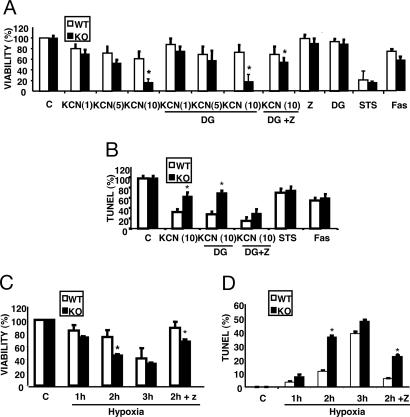Fig. 1.
BI-1 deficiency sensitizes to cell death induced by OGD. Hepatocytes were isolated from adult wild-type (+/+) and knockout (−/−) mice. (A and B) Hepatocytes were cultured for 60 min in normal medium (C) or in medium containing 20 mM deoxyglucose (DG), 2.5, 5, or 10 mM KCN, or the combination (OGD), then washed and cultured 1 day in normal medium with or without 50 μM benzoyl-Val-Ala-Asp-fluoromethyl-ketone (z). As positive controls, hepatocytes were also treated with 10 μM staurosporine (STS) or 500 ng/ml anti-Fas (Fas) for 24 h. After treatments, the percentages of viable cells (A) (relative to control) (3-(4,5-dimethylthiazol-2-yl)-2,5-diphenyl tetrazolium bromide assay) and TUNEL-positive cells (B) were quantified (mean ± SD; n = 5). (C and D) Hepatocytes were cultured for 1–3 h in medium lacking glucose in 1% O2, then washed and switched to normal medium and atmosphere, with or without 50 μM z. The percentages of viable (C) and TUNEL-positive (D) cells were quantified (mean ± SD; n = 4).

